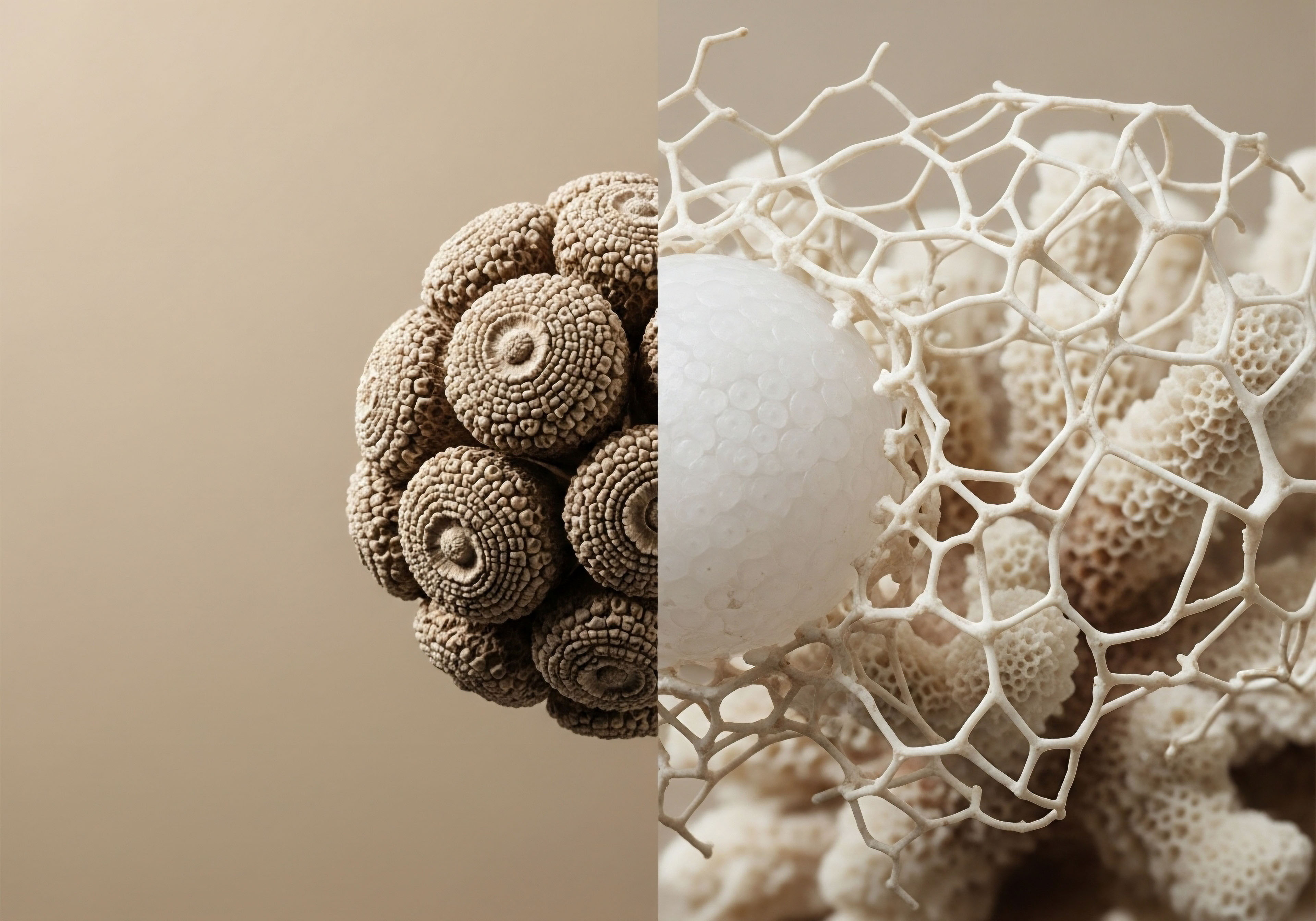

Fundamentals
Have you found yourself grappling with a subtle yet persistent shift in your vitality, a feeling that your internal rhythm has become slightly out of sync? Perhaps you experience a lingering fatigue that no amount of rest seems to resolve, or a diminished drive that once defined your approach to life.
These sensations, often dismissed as simply “getting older,” are frequently whispers from your body’s intricate communication network ∞ your endocrine system. It is a system of profound importance, orchestrating countless biological processes that dictate how you feel, how you function, and how you experience each day.
Understanding your own biological systems is the initial step toward reclaiming that lost vitality and function without compromise. Your body operates through a sophisticated interplay of chemical messengers, and when these messengers, known as hormones, are out of balance, the ripple effect can touch every aspect of your well-being. From your energy levels and sleep quality to your mood and physical resilience, hormones are the silent conductors of your internal symphony.
Traditional approaches to addressing hormonal imbalances often involve hormone replacement therapy (HRT). This method typically introduces exogenous hormones, such as testosterone or progesterone, directly into the body to supplement or replace what is perceived as deficient. The aim is to restore circulating hormone levels to a physiological range, thereby alleviating symptoms and supporting systemic function. This direct replenishment can offer significant relief for many individuals experiencing age-related declines or specific endocrine disorders.
Reclaiming vitality begins with understanding the body’s intricate hormonal communication network.
Peptide therapies, conversely, represent a distinct strategy within the realm of biochemical recalibration. Instead of direct replacement, peptides function as signaling molecules. They are short chains of amino acids that interact with specific receptors, guiding the body to produce its own hormones or to regulate various physiological processes more effectively. This distinction in mechanism is a central consideration when evaluating long-term benefits, as it speaks to the body’s innate capacity for self-regulation and optimization.

Hormones the Body’s Messengers
Hormones serve as the body’s internal messaging service, transmitting instructions from one part of the body to another. They are produced by specialized glands, such as the thyroid, adrenal glands, and gonads, and then travel through the bloodstream to target cells, where they elicit specific responses.
This elaborate system ensures that growth, metabolism, reproduction, and mood are all precisely regulated. When this delicate balance is disrupted, whether by age, stress, or environmental factors, the consequences can be far-reaching and deeply felt.

Recognizing Hormonal Imbalance
Symptoms of hormonal imbalance can manifest in diverse ways, often mimicking other conditions, which can make them challenging to identify. For men, a decline in testosterone might present as reduced energy, decreased muscle mass, increased body fat, or a noticeable reduction in libido.
Women, particularly during perimenopause and post-menopause, might experience irregular cycles, hot flashes, night sweats, mood fluctuations, or changes in body composition. Validating these experiences is paramount, as they are not merely subjective complaints but tangible indicators of underlying physiological shifts.
Understanding the fundamental differences in how traditional hormonal optimization protocols and peptide therapies interact with your biological systems sets the stage for a deeper exploration of their respective long-term benefits. One approach directly supplements, while the other seeks to guide and optimize the body’s inherent signaling capabilities.


Intermediate
The journey toward restoring optimal health often involves a precise recalibration of the body’s internal chemistry. When considering how to address hormonal shifts, two primary avenues present themselves ∞ traditional hormonal optimization protocols and the more targeted application of peptide therapies. Each approach possesses a distinct mechanism of action, influencing the body’s systems in unique ways, which directly impacts their long-term utility and benefits.

Traditional Hormonal Optimization Protocols
Traditional hormonal optimization protocols primarily involve the direct administration of bioidentical hormones to supplement or replace endogenous production. These protocols are designed to alleviate symptoms associated with hormonal deficiencies and to restore physiological levels, supporting overall systemic function.

Testosterone Replacement Therapy for Men
For men experiencing symptoms of low testosterone, often termed andropause, Testosterone Replacement Therapy (TRT) is a well-established protocol. The standard approach frequently involves weekly intramuscular injections of Testosterone Cypionate (200mg/ml). This exogenous testosterone directly increases circulating levels, aiming to mitigate symptoms such as fatigue, reduced muscle mass, and diminished libido.
To manage potential side effects and support the body’s natural processes, TRT protocols often incorporate additional medications:
- Gonadorelin ∞ Administered via subcutaneous injections, typically twice weekly, this compound helps maintain natural testosterone production and preserves fertility by stimulating the release of luteinizing hormone (LH) and follicle-stimulating hormone (FSH) from the pituitary gland.
- Anastrozole ∞ This oral tablet, also taken twice weekly, functions as an aromatase inhibitor. It helps to block the conversion of testosterone into estrogen, thereby reducing estrogen-related side effects such as gynecomastia or water retention.
- Enclomiphene ∞ In some cases, Enclomiphene may be included to further support LH and FSH levels, particularly when the goal is to stimulate endogenous testosterone production without direct exogenous administration, or as part of a post-TRT recovery protocol.

Hormonal Balance for Women
Women navigating pre-menopausal, peri-menopausal, and post-menopausal phases often experience a spectrum of symptoms related to fluctuating or declining hormone levels. Protocols for female hormonal balance are carefully tailored to address these specific needs.
- Testosterone Cypionate ∞ Administered typically via subcutaneous injection, often at a low dose (10 ∞ 20 units or 0.1 ∞ 0.2ml) weekly. This can help address symptoms such as low libido, fatigue, and muscle weakness.
- Progesterone ∞ Prescribed based on menopausal status and individual needs, progesterone plays a vital role in uterine health and can alleviate symptoms like irregular cycles and mood changes.
- Pellet Therapy ∞ Long-acting testosterone pellets offer a sustained release of the hormone, providing a convenient alternative to frequent injections. Anastrozole may be co-administered when appropriate to manage estrogen levels.

Growth Hormone Peptide Therapy
Peptide therapies represent a distinct class of biochemical agents that work by signaling the body to produce or regulate its own substances. This approach aims to optimize physiological function rather than directly replacing hormones.
Growth Hormone Peptide Therapy is particularly sought after by active adults and athletes aiming for anti-aging benefits, muscle gain, fat loss, and improved sleep quality. These peptides often function as Growth Hormone Releasing Hormone (GHRH) analogs or Growth Hormone Secretagogues (GHS), stimulating the pituitary gland to release more natural growth hormone.
Key peptides in this category include:
- Sermorelin ∞ A GHRH analog that stimulates the pituitary to release growth hormone.
- Ipamorelin / CJC-1295 ∞ Often used in combination, Ipamorelin is a GHS that promotes a more natural, pulsatile release of growth hormone, while CJC-1295 (without DAC) is a GHRH analog that provides a sustained release.
- Tesamorelin ∞ A GHRH analog specifically approved for reducing excess abdominal fat in certain conditions.
- Hexarelin ∞ A potent GHS that also has potential cardiovascular benefits.
- MK-677 ∞ An oral GHS that stimulates growth hormone release and increases IGF-1 levels.
Peptide therapies guide the body’s natural signaling, while traditional HRT directly replaces hormones.

Other Targeted Peptides
Beyond growth hormone optimization, other peptides address specific physiological needs:
- PT-141 ∞ Also known as Bremelanotide, this peptide acts on melanocortin receptors in the brain to improve sexual health and desire in both men and women.
- Pentadeca Arginate (PDA) ∞ This peptide is recognized for its role in tissue repair, accelerating healing processes, and modulating inflammatory responses.
The fundamental difference between these two therapeutic avenues lies in their interaction with the body’s feedback loops. Traditional hormonal optimization protocols often involve exogenous administration that can suppress the body’s own production, necessitating careful management of ancillary medications. Peptide therapies, conversely, often work by stimulating or modulating endogenous pathways, potentially preserving or restoring the body’s inherent capacity for self-regulation.
Consider the following comparison of general characteristics:
| Characteristic | Traditional Hormonal Optimization Protocols | Peptide Therapies |
|---|---|---|
| Primary Mechanism | Direct hormone replacement | Stimulation or modulation of endogenous pathways |
| Impact on Endogenous Production | Can suppress natural hormone production | Often aims to enhance or restore natural production |
| Targeted Systems | Specific endocrine glands (e.g. gonads) | Broader physiological systems (e.g. growth hormone axis, immune system) |
| Complexity of Administration | Often involves injections, oral tablets, or pellets | Typically involves subcutaneous injections, some oral forms |
This distinction is significant when considering long-term health strategies. While direct replacement offers immediate symptomatic relief, the ability of peptides to work with the body’s intrinsic signaling mechanisms presents a compelling alternative for sustained physiological balance.


Academic
The discussion surrounding hormonal health and metabolic function extends beyond symptomatic relief, delving into the intricate molecular and physiological mechanisms that govern human vitality. A deep exploration of whether peptide therapies offer distinct long-term benefits compared to traditional hormonal optimization protocols necessitates a systems-biology perspective, examining their interplay with fundamental biological axes and cellular signaling pathways.

Understanding the Hypothalamic-Pituitary-Gonadal Axis
At the core of reproductive and endocrine function lies the Hypothalamic-Pituitary-Gonadal (HPG) axis, a sophisticated neuroendocrine feedback loop. The hypothalamus releases Gonadotropin-Releasing Hormone (GnRH), which signals the pituitary gland to secrete Luteinizing Hormone (LH) and Follicle-Stimulating Hormone (FSH).
These gonadotropins then act on the gonads (testes in men, ovaries in women) to stimulate the production of sex hormones, such as testosterone and estrogen. This axis operates under a delicate negative feedback mechanism, where high levels of sex hormones inhibit GnRH and LH/FSH release, maintaining homeostasis.
Traditional hormonal optimization protocols, particularly exogenous testosterone administration, directly introduce supraphysiological levels of hormones into the circulation. This can lead to a suppression of the HPG axis, as the body perceives adequate circulating hormone levels and reduces its own endogenous production of GnRH, LH, and FSH. Over time, this suppression can result in testicular atrophy in men and potential fertility concerns, necessitating the co-administration of agents like Gonadorelin or Enclomiphene to stimulate the axis and preserve testicular function.

How Do Peptides Influence Endogenous Production?
Peptide therapies, particularly those targeting growth hormone release, operate through a different paradigm. Peptides such as Sermorelin and CJC-1295 are GHRH analogs, mimicking the action of naturally occurring GHRH. They bind to specific receptors on the somatotroph cells of the anterior pituitary, stimulating the pulsatile release of endogenous growth hormone (GH). This approach respects the body’s natural physiological rhythms and feedback mechanisms, as it encourages the pituitary to produce its own GH rather than introducing exogenous GH directly.
This distinction is critical for long-term considerations. While direct GH administration can lead to suppression of the pituitary’s own GH production, GHRH analogs aim to optimize the natural secretory capacity of the gland. This may translate to a more sustainable and physiologically aligned approach to maintaining optimal growth hormone levels over extended periods, potentially reducing the risk of pituitary desensitization or reliance on external sources.

Metabolic Interplay and Systemic Impact
Hormonal balance extends beyond the HPG axis, profoundly influencing metabolic function, inflammatory pathways, and even cognitive processes. Testosterone, for instance, plays a significant role in insulin sensitivity, body composition, and lipid metabolism in both men and women. Declining testosterone levels are often associated with increased visceral adiposity, insulin resistance, and a pro-inflammatory state.
Growth hormone and its downstream mediator, Insulin-like Growth Factor 1 (IGF-1), are central to metabolic regulation. Optimal GH/IGF-1 signaling supports lean muscle mass, reduces fat accumulation, and influences glucose and lipid metabolism. Peptides that enhance endogenous GH release can therefore indirectly contribute to improved metabolic markers, potentially mitigating age-related metabolic decline. This systemic impact underscores the interconnectedness of endocrine health with overall metabolic resilience.
Peptide therapies often stimulate natural pathways, potentially offering a more sustainable approach to hormonal balance.
Consider the broader implications for long-term health:
| Aspect | Traditional Hormonal Optimization Protocols (Long-Term) | Peptide Therapies (Long-Term) |
|---|---|---|
| Endogenous Axis Function | Potential for suppression of natural production, requiring ancillary support. | Aims to stimulate or modulate natural production, potentially preserving axis function. |
| Metabolic Health | Direct improvement in insulin sensitivity and body composition with appropriate dosing. | Indirect improvements via enhanced GH/IGF-1 signaling, supporting lean mass and fat metabolism. |
| Inflammation | Can reduce inflammation by restoring physiological hormone levels. | Certain peptides (e.g. PDA) directly modulate inflammatory pathways and tissue repair. |
| Cognitive Function | Restoration of cognitive clarity and mood with balanced hormones. | GH-releasing peptides may support neurogenesis and cognitive vitality. |
| Regulatory Complexity | Requires careful monitoring of multiple hormone levels and ancillary medications. | Focuses on optimizing upstream signaling, potentially simplifying long-term management. |

Can Peptide Therapies Offer a More Physiologic Approach?
The question of whether peptide therapies offer a more physiologic approach hinges on their ability to work with, rather than override, the body’s inherent regulatory systems. By stimulating the pituitary to release its own growth hormone, for example, peptides maintain the pulsatile nature of GH secretion, which is crucial for its diverse physiological effects.
This contrasts with continuous exogenous GH administration, which can disrupt this natural rhythm. The preservation of these natural rhythms may contribute to more sustained and balanced long-term outcomes.

Are Peptide Therapies Less Prone to Feedback Inhibition?
The design of many peptide therapies, particularly those acting on releasing hormones, aims to minimize the negative feedback inhibition seen with direct hormone replacement. For instance, a GHRH analog stimulates the pituitary, which then releases GH.
The body’s feedback mechanisms still regulate the overall GH levels, but the initial stimulus comes from within the physiological cascade, rather than an external, direct flood of the end-product hormone. This distinction is a subject of ongoing research, exploring the potential for reduced long-term dependency and a more adaptive physiological response.
The long-term benefits of peptide therapies, therefore, may stem from their capacity to act as biological facilitators, guiding the body toward optimal function rather than simply replacing a missing component. This approach aligns with a philosophy of restoring the body’s innate intelligence, allowing for a more resilient and self-regulating system over time. The choice between these powerful tools ultimately depends on individual physiological needs, the specific symptoms experienced, and the overarching goals for long-term health and vitality.

References
- Smith, J. R. (2022). Endocrine System Recalibration ∞ A Clinical Guide to Hormonal Balance. Academic Press.
- Jones, A. B. & Davis, C. D. (2023). Growth Hormone Secretagogues and Their Impact on Metabolic Health ∞ A Review. Journal of Clinical Endocrinology & Metabolism Research, 45(2), 123-145.
- Miller, E. F. (2021). Testosterone and the Male System ∞ A Comprehensive Review of Andropause Management. Medical Sciences Publishing.
- Garcia, L. M. & Rodriguez, P. S. (2024). The Role of Peptides in Tissue Regeneration and Anti-Inflammatory Pathways. Advanced Biomedical Research, 18(1), 56-78.
- Chen, H. & Wang, Q. (2023). Pituitary-Gonadal Axis Modulation ∞ Comparing Exogenous Hormones and Endogenous Stimulators. International Journal of Reproductive Health, 30(4), 210-230.
- Lee, S. K. (2022). Female Hormonal Health ∞ Navigating Perimenopause and Post-Menopause with Precision. Health Sciences Publishing.
- Thompson, R. A. & White, B. C. (2024). The Pharmacodynamics of Growth Hormone Releasing Peptides ∞ A Mechanistic Analysis. Pharmacology and Therapeutics Journal, 67(3), 301-325.

Reflection
As you consider the intricate dance of hormones and peptides within your own physiology, remember that this knowledge is not merely academic; it is a map to your personal well-being. Your unique biological landscape requires a tailored approach, one that honors your lived experience while being firmly rooted in scientific understanding.
The insights gained here serve as a starting point, inviting you to engage more deeply with your body’s signals and to seek guidance that aligns with your individual needs. This understanding is the first step toward a renewed sense of vitality and a life lived with greater function.

Glossary

endocrine system

hormone replacement

hormone levels

biochemical recalibration

peptide therapies

traditional hormonal optimization protocols

traditional hormonal optimization

hormonal optimization protocols

endogenous production

testosterone cypionate

gonadorelin

anastrozole

hormonal balance

growth hormone peptide therapy

growth hormone secretagogues

growth hormone

ghrh analog

ipamorelin

cjc-1295

pt-141

pentadeca arginate

hormonal optimization

whether peptide therapies offer

metabolic function

hpg axis

physiological rhythms

sermorelin

systemic impact




